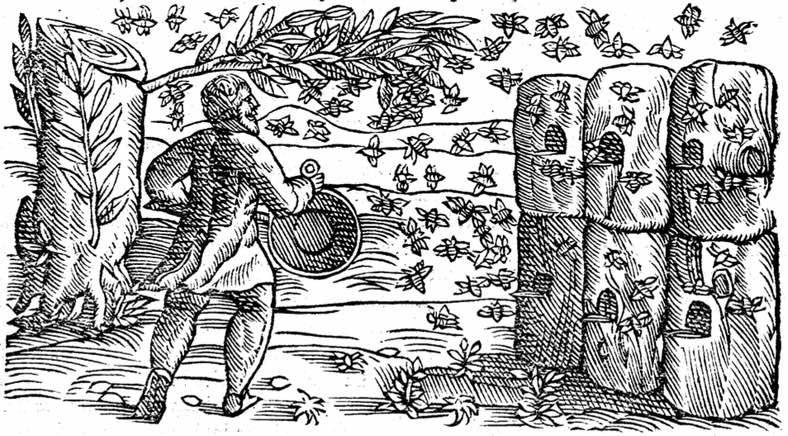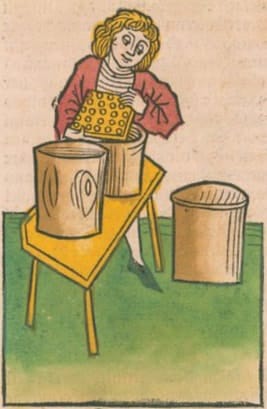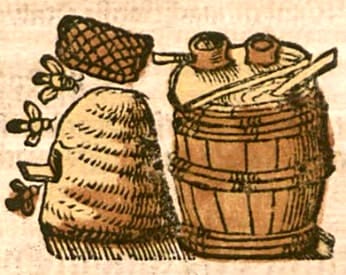Honey, Mel, Feng Mi 蜂蜜Feng Mi (TCM)Asl (Unani) Sbrang rtsi སྦྲང་རྩི (Tibetan) |

|
 Dioscorides Materia Medica, Mathias, 1563
Dioscorides Materia Medica, Mathias, 1563 Ortus Sanitatis, Meydenbach, 1491
Ortus Sanitatis, Meydenbach, 1491 Krauterbuch, Lonitzer, 1578
Krauterbuch, Lonitzer, 1578Entomological name:
Apis spp.
- A. mellifera, Western Honey Bee,
- A. cerana, Eastern Honey Bee
Parts used:
Honey, raw or clarified
Temperature & Taste:
Warm, Sweet.
Avicenna said “Honey is hot and dry in the second degree”. He noted that some Honey was mildly Moist.
Uses:
1. Nourishes and Moistens the Lungs (West, TCM, Ayurveda):
-chronic, dry-type Coughs, Asthma, and Bronchitis.
-dry mouth and sore throat.
-has successfully been used as an inhalation in cases of atrophy of the Lungs (10% in hot water).
-Vedic texts note Cachexia and Consumption is best treated with Milk and Honey.
2. Benefits Digestion, Strengthens the Spleen, Tonifies the Qi:
-promotes strength and vigor, and improves intellect
-Extended use was said to strengthen the Will, make the body light and free from hunger.
-promotes good complexion.
-regarded as an elixir of Youth in several cultures.
-weakness and debility following chronic illness
-Honey benefits the dryness and weakness of elderly, and supports the growth and development of the young.
-constipation from dryness or weakness, especially in the elderly.
-chronic Hepatitis.
-Ayurveda uses Honey in the treatment of Diabetes and Obesity; old Honey is best for reducing Blood Sugar.
-Hiccup, Vomiting and Thirst (for these purposes it may be taken with Lemon juice).
-Honey reduces excess acidity and heals the membranes, so is used for Heartburn and gastro-duodenal ulcers
-“Honey water strengthens the Stomach and increases Appetite”. (Avicenna)
3. Resists Poison, Clears Toxins:
-detoxicant effect which makes it useful both as a medicine itself, or to add to other medicines to form a syrup. It is sometimes used to prepared other medicines with for this purpose
-used as an antidote to Mineral, Vegetable and Animal poisons.
-Colds and Flu (either with Lemon juice, Horseradish juice, Garlic, or a suitable infusion)
-during and after infectious diseases like Measles and Mumps.
-traditionally used as a Hangover remedy.
-“licked by patients affected by Rabid Dogs’ bite and virulent Fungus” (Avicenna)
4. Benefits the Heart:
-Heart Disease, Angina and Heart insufficiency.
–Avicenna recommended Honey for the Heart. Modern research has shown 50-100 grams daily to be beneficial in many Heart disease patients.
5. Clears Phlegm:
-Honey has a special virtue to help clear Phlegm (being one of the few sweet things that doesn’t increase Phlegm).
-Used in Ayurveda for this purpose, and also in the west with Vinegar as Oxymel.
-Taking Honey liquifies and clears gastric mucus.
-“It clears obstructions from lumen of veines, removes moistures and absorbs fluids of the deep parts of the body”. (Avicenna)
6. Promotes Healing:
-all internal and external ulcers, including mouth and stomach ulcers;
-promotes healing internally and externally
-“It stops putrefaction and decay of the flesh” (Avicenna)
7. Benefits the Eyes:
-long recommended for Eye diseases (since Ebers Papyrus)
-inflammations, conjunctivitis, keratitis, corneal ulcers
-very useful for burns of the eye.
-“Honey cures dim vision” (Avicenna)
8. Yogavaha:
-meaning it increases the medicinal effects of medicines which it is added to (Ayurveda)
-similarly recognised in old TCM texts: ‘It eliminates multitudes of diseases and harmonizes hundreds of medicines’ (Bensky).
-Honey is used in the preparation of medicines: Stir frying medicines in honey increases the nourishing, moistening, and tonifying effects.
-used as a sweetener and preservative in cough medicines and syrups, and is a good vehicle to take various medicines in.
9. Externally:
-good application to Bee stings
-applied to the eyes for red, sore and inflamed Eyes.
-applied to Wounds, Sores, Shingles, Herpes, skin disorders including Eczema,
-Burns and Scalds, to help promote healing.
-gargling with Honey cures Tonsilitis. (Avicenna)
-very useful for chronic non-healing Wounds and Ulcers
-poultice with flour to abscesses
-Honey has been applied to skin tuberculosis with benefit.
Preparation:
CLARIFIED HONEY:
1. To clarify Honey (for distilling etc) ‘the best way being only to hang the Combs in a bag of transparent cloth in a place that is close and naturally hot, and to let the Honey drop of itself, by which means you neither take away its whiteness nor its other good qualities either by fire or other ways’. (French Pharmacopoeia)
2. Take one part Honey and 4 parts spring water; boil in a brass pot, removing the wax and other impurities as they arise, then boil down gently until all the water has evaporated. ‘It is the best sort of honey for medicine or dietic purposes’. This is the method most used when ‘Clarified Honey’ is needed.
3. Another method of clarifying Honey was with the white of an egg: Egg white was beaten to a froth, then mixed with the Honey, then they are gently boiled and the scum removed. (All the ‘filth’ was attracted to the Egg White)
Dose:
10–30 grams, up to three times daily
Correctives:
1. Lemon juice
2. Vinegar (sours in general)
Substitutes:
1. Dates
2. Molasses
Main Combinations:
1. To strengthen the Lungs and relieve Thirst:
i. boil Honey in water (Hydromel)
ii. boil Honey in Barley water
iii. decoct Raisins, Dates and Almonds, strain and add Honey
2. To prepare and cut through tough Phlegm, Honey with Vinegar (Oxymel)
3. Insomnia;
i. Honey in warm milk
ii. An old Slavic remedy combines 2 tablespoons of dark Honey with the juices of an Orange and a Lemon
4. Difficult labor and transverse presentation, take Honey with Sesame Oil.
5. Obesity: Take 2 oz. of Honey every morning with Cold water to reduce weight. Honey has been used for obesity for a long time in various cultures.
6. Leprosy; Two parts of Fresh Ginger is boiled in 1 part of Honey until 1 part remains. This is formed into Date size pills. One pill is taken 3 times daily with warm wine for ‘Leprosy of 30 years standing’. Cold, smelly, and slippery things, as well as Vinegar, are not allowed. (TCM)
7. Opium addiction: “Oral intake of warm Honey with rose-oil proves to be useful in cases of Insect Bite and Opium addiction” (Avicenna)
Externally:
8. Bruising, boil Honey combs in wine to form a plaster.
9. Toxic boils and abscesses, Wormwood, Vinegar and Honey
10. Indolent Ulcers, prepare a plaster of Honey with Wax (Ceromel)
11. To promote hair growth, mix beaten onion with olive oil and Honey to form an ointment. (The Physicians of Myddvai, translated by John Pughe esq., 1861)
12. Frackles, mix powdered Costus with Honey and apply. (Avicenna)
13. Bruising, apply Honey and Salt. (Avicenna)
14. Ringworm: “When smeared with Dill, it cures Ringworm”. (Avicenna)
15. Ulcers of the Ear, applied lukewarm with Salt. (Avicenna)
Cautions:
1. ‘Not only Hippocrates but all physicians say that Honey is bad in Bilious diseases but good in old Age … Honey is good for an old Man and not for a young one, that it is harmful for those that are naturally Bilious, and serviceable for those who are Phlegmatic. In a word, in bodies which are warm either through nature, disease, time of life, season of the year, locality or occupation, Honey is productive of Bile, whereas in opposite circumstances it produces Blood’. (Galen, ‘On the Natural Faculties’, 170AD)
2. Honey should not be used in chronic diarrhea.
3. Ayurveda says Honey should never be heated. Cooking is said to slow its digestion, congest the mucus membranes and subtle energy channels: ‘Uncooked Honey is Nectar; Cooked Honey is Poison’. However, when clarified, the toxic nature of heating honey is removed.
4. Hildegard said Honey creates Fat and Pus in fat people if overeaten.
Main Preparations used:
Hydromel, Oxymel, Tincture
1. TINCTURE of HONEY.
Best Honey 2 lbs.
Fine, White, Dry sand 3 lbs.
Spirit of Wine 2 lbs.
Digest warm, filter, and in Balneo Marie evaporate to the consistency of a Syrup.
Used for asthma, phthisick, inveterate chronic coughs, difficulty breathing etc. Also for Hectic fevers and Consumption, and to nourish the body. Dose: 2-3 spoonfuls, twice daily
GENERAL / REVIEW
–Composition and properties of Apis mellifera honey: A review
–Pharmacology of honey: A review
–Chemical composition and uses of Honey: A Review
–Medicinal uses and health benefits of honey: an overview
–Medicinal uses of honey
–Medical uses of honey
–Medicinal properties of honey: A review
–Honey-a remedy rediscovered
–Traditional and modern uses of natural honey in human diseases: a review
–Honey–a remedy rediscovered and its therapeutic utility.
–Medicinal and cosmetic uses of Bee’s Honey–A review
–Honey as medicine: historical perspectives
–Why honey is effective as a medicine. 1. Its use in modern medicine
–Honey between traditional uses and recent medicine
–Honey: nutritional and medicinal value
–Honey health benefits and uses in medicine
–History, phytochemistry, experimental pharmacology and clinical uses of honey: A comprehensive review with special reference to Unani medicine
ANTIBACTERIAL
–Antimicrobial properties of honey
–Honey and microbial infections: a review supporting the use of honey for microbial control
–Antibacterial activity of honey against strains of Staphylococcus aureus from infected wounds
–Honey: A realistic antimicrobial for disorders of the skin
–Honey: its medicinal property and antibacterial activity
WOUNDS
–The use of honey in wound management
–Medical honey for wound care—still the ‘latest resort’?
–Honey and wound healing: an overview
–Evidence for clinical use of honey in wound healing as an anti-bacterial, anti-inflammatory anti-oxidant and anti-viral agent: A review
–The potential for honey in the management of wounds and infection
–Use of honey for wound healing
